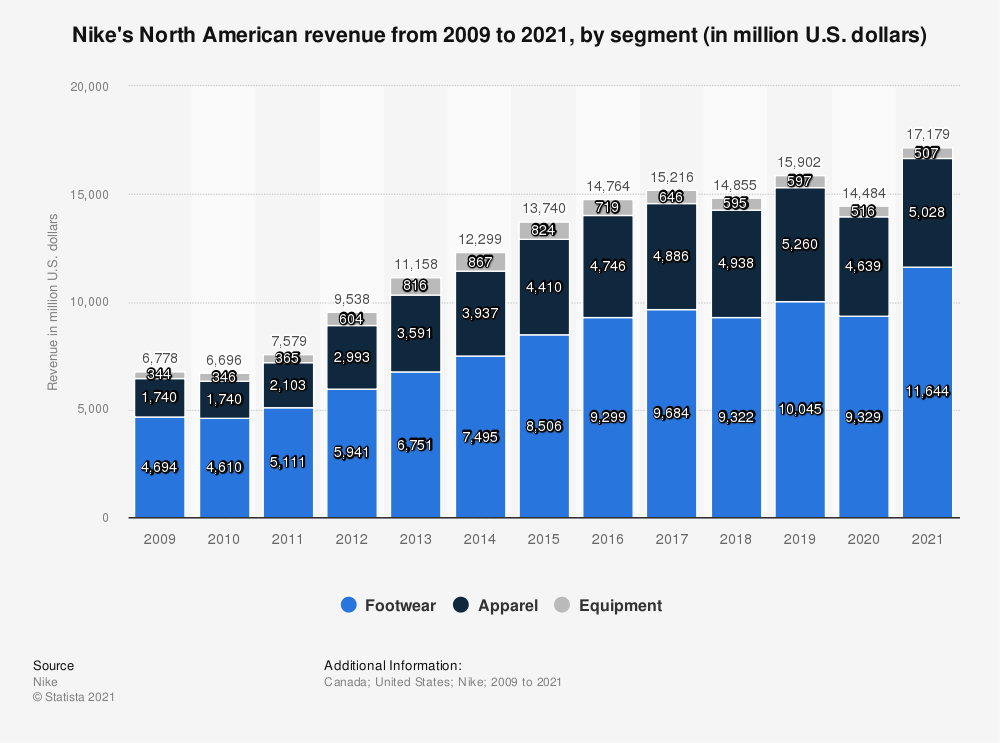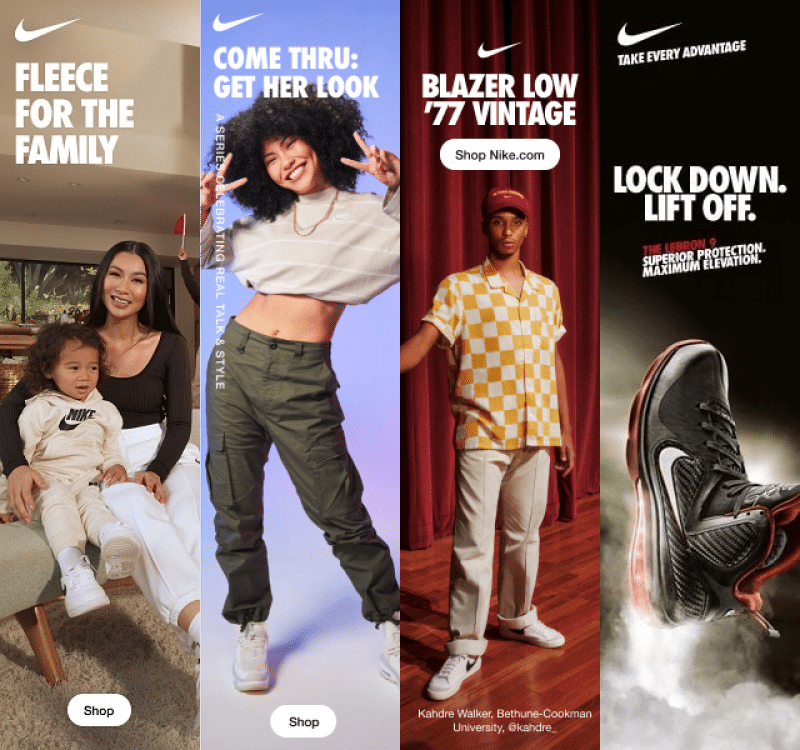Nike's target market age is the age group that the company focuses its marketing efforts on. This age group is typically between 15 and 35 years old, as this is the age group that is most likely to be interested in Nike's products.
There are a number of reasons why Nike targets this age group. First, this age group is more likely to be active and involved in sports, which makes them more likely to be interested in Nike's athletic wear. Second, this age group is more likely to be fashion-conscious, which makes them more likely to be interested in Nike's stylish designs. Finally, this age group is more likely to have disposable income, which makes them more likely to be able to afford Nike's products.
Nike's focus on this age group has been very successful. The company has become one of the most popular and successful athletic wear brands in the world. Nike's products are worn by athletes and non-athletes alike, and the company's brand is synonymous with quality and style.
Nike Target Market Age
Nike's target market age is a crucial factor that drives the company's marketing strategies. Here are 8 key aspects related to this topic:
- Age Range: 15-35 years old
- Demographics: Active, fashion-conscious, disposable income
- Psychographics: Aspiration, self-expression, exclusivity
- Marketing Channels: Social media, online advertising, influencer partnerships
- Product Focus: Athletic wear, sneakers, lifestyle apparel
- Brand Positioning: Performance, innovation, style
- Competitive Landscape: Adidas, Under Armour, Puma
- Global Reach: Targeting different age groups in various countries
These aspects highlight the importance of understanding Nike's target market age. By focusing on this specific age group, Nike effectively aligns its products, marketing efforts, and brand image to resonate with their interests, aspirations, and lifestyle.
1. Age Range
The age range of 15-35 years old is a crucial aspect of Nike's target market age. This specific age group aligns with Nike's marketing strategies and product offerings for several reasons:
- Unleashing The Beast Tom Hardys Iconic Roles
- George Clooneys Wife Amals Age A Look At Their Relationship
- Active Lifestyle: Individuals within this age range are typically more active and engaged in sports and fitness activities, making them a prime target for Nike's athletic wear and footwear.
- Fashion Consciousness: This age group is highly fashion-conscious and receptive to the latest trends. Nike's focus on stylish designs and collaborations with fashion icons resonates well with their sense of style.
- Brand Loyalty: Establishing brand loyalty at a young age is crucial for Nike. By targeting this age range, Nike aims to cultivate a long-term relationship with its customers.
Nike's understanding of its target market age allows the company to effectively tailor its products, marketing campaigns, and overall brand image to align with the aspirations, lifestyle, and purchasing habits of this specific demographic.
2. Demographics
The demographics of Nike's target market age are closely intertwined with the company's marketing strategies and product offerings. Let's explore the connection between these two aspects:
- Active Lifestyle:
Nike targets individuals who are active and engaged in sports and fitness activities. This aligns with the company's focus on athletic wear and footwear. By catering to this active demographic, Nike positions itself as a brand that supports and empowers athletic endeavors.
- Fashion Consciousness:
Nike's target market is also highly fashion-conscious. The company's products are not just about performance but also about style. Nike collaborates with fashion icons and designers to create limited-edition collections that cater to the latest trends. This fashion-forward approach resonates with the style-conscious demographic that Nike targets.
- Disposable Income:
Nike's target market typically has disposable income, which enables them to purchase the company's products. This is particularly relevant for Nike's premium and limited-edition items, which come with a higher price tag. By focusing on individuals with disposable income, Nike ensures that its products are accessible to its target market.
In summary, Nike's target market age is closely linked to the demographics of active, fashion-conscious, and disposable income individuals. Understanding these demographics allows Nike to tailor its products, marketing campaigns, and overall brand image to align with the aspirations, lifestyle, and purchasing behavior of its target audience.
3. Psychographics
The psychographics of Nike's target market age are equally important as their demographics. Psychographics refer to the psychological characteristics, values, and lifestyle of a target market. For Nike, understanding the psychographics of their target market allows them to create marketing campaigns and products that resonate on a deeper level.
Aspiration is a key psychographic for Nike's target market. This age group is ambitious and driven, and they aspire to achieve great things in their lives. Nike's marketing campaigns often feature athletes and other successful individuals who embody this aspiration. By associating with these individuals, Nike positions itself as a brand that can help consumers achieve their own goals.
Self-expression is another important psychographic for Nike's target market. This age group is highly individualistic and they want to express their own unique style. Nike's products allow consumers to do just that. With a wide range of styles and colors to choose from, consumers can find Nike products that reflect their own personality and style.
Exclusivity is also a key psychographic for Nike's target market. This age group wants to feel like they are part of an exclusive club. Nike's products help to create this feeling of exclusivity. By wearing Nike products, consumers can feel like they are part of a community of like-minded individuals who share their values and aspirations.
Understanding the psychographics of their target market age is essential for Nike's success. By creating marketing campaigns and products that resonate with the aspirations, values, and lifestyle of their target market, Nike is able to build a strong and lasting relationship with its customers.
4. Marketing Channels
Nike effectively utilizes various marketing channels to reach and engage its target market age group. These channels include social media, online advertising, and influencer partnerships, each playing a distinct role in connecting with the target audience.
- Social Media:
Social media platforms like Instagram, TikTok, and Snapchat are crucial for Nike to connect with its target market age. These platforms allow Nike to share product updates, showcase athlete endorsements, and engage with consumers in real-time. Nike's social media presence is highly interactive, encouraging user-generated content and fostering a sense of community among its followers.
- Online Advertising:
Nike leverages online advertising channels such as search engine marketing and display advertising to reach its target market. By strategically placing ads on relevant websites and search results, Nike ensures that its products are visible to potential customers who are actively seeking athletic wear and footwear.
- Influencer Partnerships:
Nike collaborates with influential individuals, including athletes, celebrities, and social media stars, to promote its products to its target market age. These influencers often align with Nike's brand image and values, allowing the company to tap into the influencer's established audience and credibility. Influencer partnerships help Nike create authentic and engaging content that resonates with its target market.
By leveraging these marketing channels, Nike effectively reaches and engages its target market age. The combination of social media, online advertising, and influencer partnerships allows Nike to build strong relationships with its customers, drive brand awareness, and ultimately increase sales.
5. Product Focus
Nike's product focus on athletic wear, sneakers, and lifestyle apparel is closely aligned with its target market age. This focus stems from a deep understanding of the needs and aspirations of individuals within the 15-35 age range. Here's how these product categories connect with the target market age:
- Athletic Wear: The target market age is highly active and engaged in sports and fitness activities. Nike's athletic wear is designed to meet the performance and comfort needs of these individuals, providing them with the necessary gear to excel in their pursuits.
- Sneakers: Sneakers are a staple footwear choice for the target market age, blending style and functionality. Nike's iconic sneaker designs cater to the fashion-conscious nature of this demographic, while also providing the comfort and support needed for everyday wear.
- Lifestyle Apparel: Beyond athletic wear and sneakers, Nike's lifestyle apparel line offers a range of casual and stylish clothing items. This aligns with the target market's desire for self-expression and individuality, allowing them to incorporate Nike into their everyday wardrobe.
By focusing on these product categories, Nike effectively caters to the lifestyle, aspirations, and fashion preferences of its target market age. This understanding enables Nike to create products that resonate with the target audience, building brand loyalty and driving sales.
6. Brand Positioning
Nike's brand positioning as a symbol of performance, innovation, and style holds a significant connection to its target market age. This strategic positioning resonates with the aspirations, values, and lifestyle of individuals within the 15-35 age range:
- Performance: The target market age is highly active and engaged in sports and fitness activities. Nike's emphasis on performance-driven products aligns with their pursuit of excellence and achievement.
- Innovation: This age group embraces innovation and seeks products that incorporate the latest technologies. Nike's commitment to innovation, showcased through its cutting-edge designs and materials, appeals to their desire for forward-thinking and originality.
- Style: The target market age is highly fashion-conscious and places importance on personal style. Nike's stylish designs and collaborations with fashion icons cater to their need for self-expression and individuality.
By effectively embodying these attributes, Nike establishes a strong connection with its target market age. This positioning enables Nike to create products and marketing campaigns that resonate with the target audience, driving brand loyalty and sales.
7. Competitive Landscape
The competitive landscape within the athletic wear industry, particularly in relation to Nike's target market age, plays a crucial role in shaping Nike's marketing strategies and product offerings. Here are key aspects to consider:
- Market Share and Brand Perception: Adidas, Under Armour, and Puma are significant competitors to Nike, each holding a portion of the market share and possessing distinct brand perceptions among the target market age. Understanding the strengths and weaknesses of these competitors enables Nike to differentiate its offerings and target specific segments effectively.
- Product Innovation and Technology: In an industry driven by innovation, Nike closely monitors the advancements made by its competitors. Adidas's focus on performance technologies, Under Armour's emphasis on moisture-wicking fabrics, and Puma's collaborations with renowned designers influence Nike's own research and development efforts to stay competitive.
- Marketing and Advertising Strategies: The competitive landscape also involves assessing the marketing and advertising strategies employed by rivals. Nike analyzes the target market reach, messaging, and promotional campaigns of Adidas, Under Armour, and Puma to identify opportunities for differentiation and to optimize its own marketing efforts.
- Target Market Overlap: While Nike's target market age aligns primarily with the 15-35 age range, there is some overlap with the target markets of Adidas, Under Armour, and Puma. Understanding the areas of overlap and the unique value proposition offered by each brand helps Nike refine its targeting strategies to maximize market penetration.
By carefully considering the competitive landscape and the dynamics involving Adidas, Under Armour, and Puma, Nike can make informed decisions about product development, marketing campaigns, and overall brand positioning to maintain its competitive edge and resonate with its target market age.
8. Global Reach
Nike's target market age extends beyond a single age range due to its global reach and the varying demographics of different countries. The company tailors its marketing strategies and product offerings to resonate with the specific age groups that represent its target market in each region.
- Cultural and Regional Differences:
Nike recognizes that cultural and regional differences influence consumer behavior and preferences. In countries with a younger population, such as India and China, Nike may focus on targeting a slightly younger age group compared to markets with an older population, such as Japan or Western Europe.
- Socioeconomic Factors:
Socioeconomic factors, such as income levels and disposable income, can also impact Nike's target market age. In developing countries where disposable income is lower, Nike may offer more affordable products and target a broader age range to cater to a larger market.
- Competitive Landscape:
The competitive landscape in each country influences Nike's target market age. If a particular age group is heavily targeted by competitors, Nike may adjust its strategy to focus on a different age group to avoid direct competition.
- Legal and Regulatory Factors:
Legal and regulatory factors, such as restrictions on advertising to certain age groups, can also shape Nike's target market age in different countries. Nike ensures compliance with local laws and regulations to avoid any legal implications.
By considering the global reach and targeting different age groups in various countries, Nike effectively adapts its marketing strategies to align with the unique characteristics of each market. This approach enables the company to maximize its market penetration and resonate with consumers across diverse regions.
Frequently Asked Questions on Nike's Target Market Age
This section addresses common inquiries and misconceptions regarding Nike's target market age, providing concise and informative answers.
Question 1: What is Nike's primary target market age range?
Nike primarily targets individuals between the ages of 15 and 35.
Question 2: Why does Nike focus on this particular age group?
This age group is highly active, fashion-conscious, and has disposable income, making them a valuable target market for Nike's athletic wear and stylish designs.
Question 3: Does Nike target different age groups in different countries?
Yes, Nike tailors its marketing strategies and product offerings to resonate with the specific age groups that represent its target market in each region, considering cultural, socioeconomic, and competitive factors.
Question 4: How does Nike's target market age impact its marketing campaigns?
Understanding its target market age allows Nike to effectively align its marketing campaigns with the interests, aspirations, and lifestyle of this age group, using channels like social media and influencer partnerships.
Question 5: How does Nike differentiate itself from competitors in terms of target market age?
Nike focuses on innovation, performance, and style to appeal to its target market age, while also considering the competitive landscape and adapting its strategies to avoid direct competition.
These FAQs provide a comprehensive overview of Nike's target market age and its implications for the company's marketing strategies.
Transition to the Next Section: Understanding Nike's target market age is crucial for the company's success. By effectively targeting this specific age group, Nike can create products, marketing campaigns, and a brand image that resonates with their aspirations, lifestyle, and purchasing behavior.
Conclusion
Understanding Nike's target market age is crucial for the company's success. By effectively targeting this specific age group, Nike can create products, marketing campaigns, and a brand image that resonates with their aspirations, lifestyle, and purchasing behavior.
Nike's focus on the 15-35 age range has proven to be a strategic move, allowing the company to establish itself as a leading brand in the athletic wear industry. The company's deep understanding of this target market's demographics, psychographics, and purchase drivers enables Nike to tailor its offerings and marketing efforts to maximize its impact.
As Nike continues to navigate the evolving consumer landscape, the company's focus on its target market age will remain a cornerstone of its marketing strategy. By staying attuned to the changing needs and preferences of this age group, Nike can continue to drive growth and maintain its position as a global sportswear powerhouse.



Detail Author:
- Name : Dr. Rafael Sawayn
- Username : shickle
- Email : jenkins.carleton@heathcote.info
- Birthdate : 2006-08-02
- Address : 5970 Rosetta Radial Bartellland, NY 10332
- Phone : +1-364-823-5665
- Company : Nicolas PLC
- Job : Command Control Center Specialist
- Bio : Ad voluptatem vero et soluta. Et nostrum et eveniet pariatur tenetur. Et culpa repudiandae deleniti pariatur. Ipsam veniam reprehenderit aut pariatur eum.
Socials
facebook:
- url : https://facebook.com/freddiereichert
- username : freddiereichert
- bio : Tempore facere illum saepe autem et. Unde totam velit et voluptatem.
- followers : 1207
- following : 883
twitter:
- url : https://twitter.com/freichert
- username : freichert
- bio : Optio impedit culpa debitis laudantium quo non illum. Dolorem sed explicabo est eligendi provident voluptas sit.
- followers : 493
- following : 980